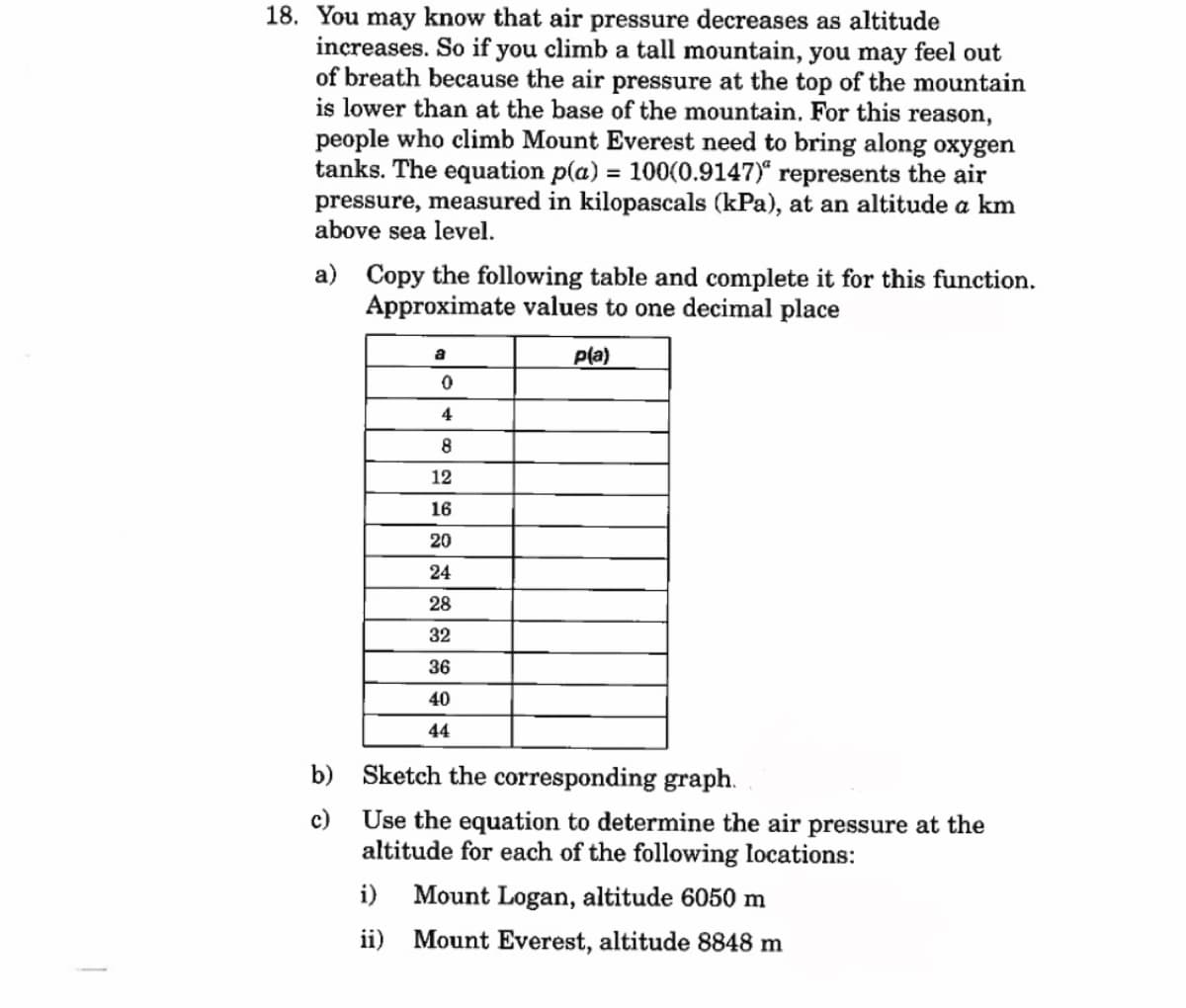18. You may know that air pressure decreases as altitude increases. So if you climb a tall mountain, you may feel out of breath because the air pressure at the top of the mountain is lower than at the base of the mountain. For this reason, people who climb Mount Everest need to bring along oxygen tanks. The equation p(a) = 100(0.9147)" represents the air pressure, measured in kilopascals (kPa), at an altitude a km above sea level. a) Copy the following table and complete it for this function. Approximate values to one decimal place p(a) a 0 4 8 12 16 20 24 28 32 36 40 44 b) Sketch the corresponding graph. c) Use the equation to determine the air pressure at the altitude for each of the following locations: i) Mount Logan, altitude 6050 m ii) Mount Everest, altitude 8848 m
18. You may know that air pressure decreases as altitude increases. So if you climb a tall mountain, you may feel out of breath because the air pressure at the top of the mountain is lower than at the base of the mountain. For this reason, people who climb Mount Everest need to bring along oxygen tanks. The equation p(a) = 100(0.9147)" represents the air pressure, measured in kilopascals (kPa), at an altitude a km above sea level. a) Copy the following table and complete it for this function. Approximate values to one decimal place p(a) a 0 4 8 12 16 20 24 28 32 36 40 44 b) Sketch the corresponding graph. c) Use the equation to determine the air pressure at the altitude for each of the following locations: i) Mount Logan, altitude 6050 m ii) Mount Everest, altitude 8848 m
Elementary Geometry For College Students, 7e
7th Edition
ISBN:9781337614085
Author:Alexander, Daniel C.; Koeberlein, Geralyn M.
Publisher:Alexander, Daniel C.; Koeberlein, Geralyn M.
Chapter9: Surfaces And Solids
Section9.CT: Test
Problem 16CT
Related questions
Question
Show details

Transcribed Image Text:18. You may know that air pressure decreases as altitude
increases. So if you climb a tall mountain, you may feel out
of breath because the air pressure at the top of the mountain
is lower than at the base of the mountain. For this reason,
people who climb Mount Everest need to bring along oxygen
tanks. The equation p(a) = 100(0.9147)" represents the air
pressure, measured in kilopascals (kPa), at an altitude a km
above sea level.
a) Copy the following table and complete it for this function.
Approximate values to one decimal place
a
0
4
8
12
16
20
24
28
32
36
40
44
p(a)
b)
Sketch the corresponding graph.
c) Use the equation to determine the air pressure at the
altitude for each of the following locations:
i) Mount Logan, altitude 6050 m
ii)
Mount Everest, altitude 8848 m

Transcribed Image Text:d) Use the equation to find the altitude that corresponds to an
air pressure of 20 kPa.
Expert Solution
This question has been solved!
Explore an expertly crafted, step-by-step solution for a thorough understanding of key concepts.
Step by step
Solved in 4 steps with 1 images

Recommended textbooks for you

Elementary Geometry For College Students, 7e
Geometry
ISBN:
9781337614085
Author:
Alexander, Daniel C.; Koeberlein, Geralyn M.
Publisher:
Cengage,

Elementary Geometry for College Students
Geometry
ISBN:
9781285195698
Author:
Daniel C. Alexander, Geralyn M. Koeberlein
Publisher:
Cengage Learning

Algebra: Structure And Method, Book 1
Algebra
ISBN:
9780395977224
Author:
Richard G. Brown, Mary P. Dolciani, Robert H. Sorgenfrey, William L. Cole
Publisher:
McDougal Littell

Elementary Geometry For College Students, 7e
Geometry
ISBN:
9781337614085
Author:
Alexander, Daniel C.; Koeberlein, Geralyn M.
Publisher:
Cengage,

Elementary Geometry for College Students
Geometry
ISBN:
9781285195698
Author:
Daniel C. Alexander, Geralyn M. Koeberlein
Publisher:
Cengage Learning

Algebra: Structure And Method, Book 1
Algebra
ISBN:
9780395977224
Author:
Richard G. Brown, Mary P. Dolciani, Robert H. Sorgenfrey, William L. Cole
Publisher:
McDougal Littell

Mathematics For Machine Technology
Advanced Math
ISBN:
9781337798310
Author:
Peterson, John.
Publisher:
Cengage Learning,

Trigonometry (MindTap Course List)
Trigonometry
ISBN:
9781337278461
Author:
Ron Larson
Publisher:
Cengage Learning

College Algebra (MindTap Course List)
Algebra
ISBN:
9781305652231
Author:
R. David Gustafson, Jeff Hughes
Publisher:
Cengage Learning